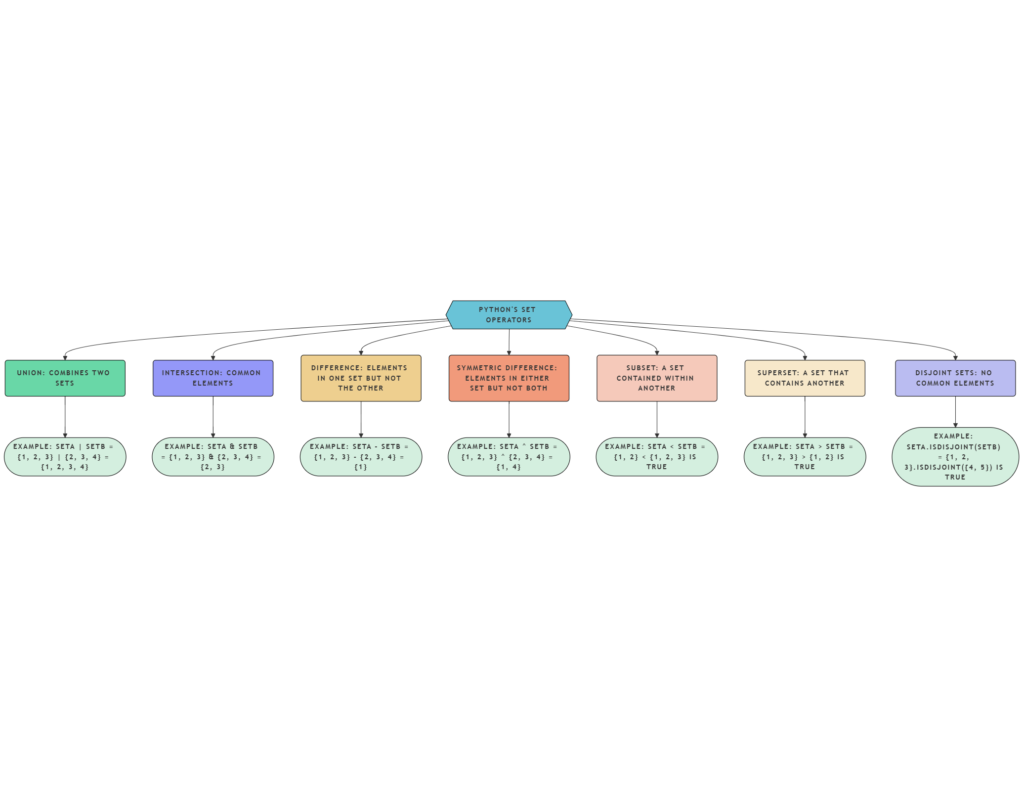In Python a set operators, sets are unordered collections of set operators that store unique elements. Sets are incredibly useful when you need to remove duplicates from a list or perform mathematical set operations such as union, intersection, and difference. These operations are optimized for speed, making sets an excellent choice for handling data where uniqueness and efficient operations are essen

What Are Set Operators?
Python sets support several built-in operations that allow you to manipulate the data stored in them. Below are the key set operators in Python:ASD
- Union (
|): This operator combines all elements from both sets. If an element is present in both sets, it will only appear once in the result. - Intersection (
&): This operator returns the common elements between two sets. - Difference (
-): This operator returns elements that are present in the first set but not in the second. - Symmetric Difference (
^): This operator returns elements that are present in either of the sets, but not in both.
These operators are efficient and optimized for quick execution, especially when compared to similar operations using lists.
Example (set operators): Union of Two Sets
Let’s look at an example of using the union operator (|). The union of two sets combines all the elements from both sets, but it eliminates duplicates.
Output:
{1, 2, 3, 4, 5}
Explanation:
The union of set1 and set2 combines all elements from both sets and removes duplicates (i.e., the element 3 appears only once).
Why Use Set Operators?
- Unique Elements: Sets automatically ensure that each element is unique. When you combine sets, duplicates are eliminated, ensuring that your data contains only distinct values.
- Efficient Operations: Set operations like union, intersection, and difference are optimized for performance. For instance, checking for membership or performing operations like union or intersection is much faster with sets compared to lists.
- Mathematical Set Operations: Sets are based on mathematical set theory, so they are ideal for solving problems like finding common elements in two datasets or performing complex operations involving multiple sets.
Mini Project: Course Enrollment with Set Operations
In this mini-project, we will simulate managing student enrollments across two courses. We will use set operations to:
- Find all unique students who are enrolled in either or both courses.
- Find students who are enrolled in both courses.
- Identify students who are only enrolled in one course.
# Mini-Project: Course Enrollment Using Set Operators
course_A = {"Alice", "Bob", "Charlie"}
course_B = {"Bob", "David", "Eva"}
# Union: All students in either course
all_students = course_A | course_B
print(f"All students: {all_students}")
# Intersection: Students in both courses
common_students = course_A & course_B
print(f"Common students: {common_students}")
# Difference: Students only in course A
unique_to_A = course_A - course_B
print(f"Students only in course A: {unique_to_A}")
Explanation:
In this mini-project:
- Union: Combines all students from both courses into one list, ensuring no duplicates.
- Intersection: Finds students who are enrolled in both courses.
- Difference: Finds students who are only enrolled in course A and not in course B.
Output:
All students: {'Alice', 'Bob', 'Charlie', 'David', 'Eva'}
Common students: {'Bob'}
Students only in course A: {'Alice', 'Charlie'}
Practical Use Cases of Set Operations
Set operations are commonly used in scenarios where you need to analyze and manipulate data. Some practical use cases include:
- Finding common elements in two datasets: For example, finding common customers in two different stores or services.
- Eliminating duplicates from a list of items: Use the
set()function to convert a list to a set, removing any duplicates. - Performing mathematical operations: Set operations like union, intersection, and difference can be used in real-world applications, such as network analysis, data mining, and more.
Interview Questions and Answers
Amazon
Q1: Why would you use sets instead of lists in Python?
A1: Sets are optimized for ensuring uniqueness and fast membership testing. Unlike lists, sets automatically remove duplicates and are more efficient for operations like union and intersection. Sets also offer O(1) time complexity for membership checks, making them faster than lists.
Q2: How would you find the difference between two sets?
A2: The difference between two sets can be found using the - operator. This returns elements that are in the first set but not in the second. For example:
set1 = {1, 2, 3}
set2 = {3, 4, 5}
difference = set1 - set2
print(difference)
Output:
{1, 2}
Zoho
Q3: How are sets useful in removing duplicates from a list?
A3: Sets automatically remove duplicates, making them an excellent tool for ensuring that a collection only contains unique elements. You can convert a list to a set using the set() function to eliminate duplicates and then convert it back to a list if needed.
For example:
my_list = [1, 2, 3, 3, 4, 5, 5] unique_elements = list(set(my_list)) print(unique_elements)
Output:
[1, 2, 3, 4, 5]
Infosys
Q4: Can set operations be performed on multiple sets at once?
A4: Yes, you can perform set operations on multiple sets at once. For example, to find the union or intersection of three sets, you can chain the operators:
set1 = {1, 2}
set2 = {2, 3}
set3 = {3, 4}
union_result = set1 | set2 | set3
intersection_result = set1 & set2 & set3
TCS
Q5: How do sets perform membership testing?
A5: Sets are highly efficient for membership testing because they use a hash-based data structure that allows for O(1) average-time complexity for membership checks. This is much faster than lists, which require O(n) time to check membership.
For example:
my_set = {1, 2, 3, 4}
print(3 in my_set) # Output: True
print(5 in my_set) # Output: False
Conclusion
Python set operators offer a fast, efficient way to work with collections of unique elements. By leveraging these operators—union, intersection, difference, and symmetric difference—you can solve a wide variety of problems in data analysis, mathematical operations, and more. Additionally, set operations are optimized for speed, making them a great choice for handling large datasets or performing membership checks.
Set Operators
Question
Your answer:
Correct answer:
Your Answers
